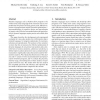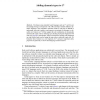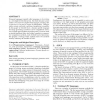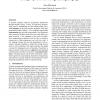ESORICS
2012
Springer
12 years 3 months ago
2012
Springer
Tracking information flow in dynamic languages remains an open challenge. It might seem natural to address the challenge by runtime monitoring. However, there are well-known funda...
HIPEAC
2011
Springer
13 years 7 days ago
2011
Springer
Dynamic typing is a barrier for JavaScript applications to achieve high performance. Compared with statically typed languages, the major overhead of dynamic typing comes from runt...
DLS
2010
13 years 10 months ago
2010
Dynamic mixin is a construct available in Ruby and other dynamic languages. It can be used as a base to implement a range of programming paradigms, such as dynamic aspectoriented ...
DLS
2010
13 years 10 months ago
2010
Dynamic languages such as Python allow programs to be written more easily using high-level constructs such as comprehensions for queries and using generic code. Efficient executio...
ECOOP
2010
Springer
14 years 2 months ago
2010
Springer
Developers using statically typed languages such as C and Java are increasingly having to interoperate with APIs and object models defined in dynamic languages. This impedance mis...
SAC
2006
ACM
14 years 6 months ago
2006
ACM
Dynamic languages typically allow programs to be written y high level of abstraction. But their dynamic nature makes it very hard to compile such languages, meaning that a price h...
OOPSLA
2007
Springer
14 years 6 months ago
2007
Springer
A dynamic language improves programmer productivity through flexible typing, a focus on high-level programming, and by streamlining the edit-compile-debug cycle. Live languages g...
EUROMICRO
2009
IEEE
14 years 7 months ago
2009
IEEE
— The usage of dynamic languages is increasing among developers. As components are static entities, the usage of scripting languages, which are usually dynamically typed and inte...
PLDI
2009
ACM
14 years 7 months ago
2009
ACM
Dynamic languages such as JavaScript are more difficult to compile than statically typed ones. Since no concrete type information is available, traditional compilers need to emit...




